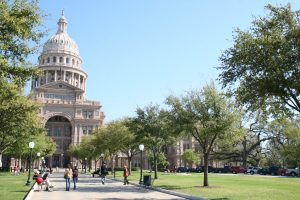 Last week, Governor Abbott signed HB 1244 into law, ensuring that future U.S. history end-of-course assessments will include 10 randomly-selected questions from the U.S. naturalization exam.[1] But for advocates of stronger civics education, this surface-level change doesn’t make up for the continued failure by state leaders to address low rates of civic engagement among young Texans, particularly those living in marginalized communities. This session, state leaders failed to pass promising reforms that would have given Texas children the opportunity to practice good citizenship in the classroom and in their communities. Lawmakers also refused to consider common sense voting rights reforms such as online voter registration.
Last week, Governor Abbott signed HB 1244 into law, ensuring that future U.S. history end-of-course assessments will include 10 randomly-selected questions from the U.S. naturalization exam.[1] But for advocates of stronger civics education, this surface-level change doesn’t make up for the continued failure by state leaders to address low rates of civic engagement among young Texans, particularly those living in marginalized communities. This session, state leaders failed to pass promising reforms that would have given Texas children the opportunity to practice good citizenship in the classroom and in their communities. Lawmakers also refused to consider common sense voting rights reforms such as online voter registration.
Legislative inaction around civics education and voting rights is not surprising but it should be concerning to every Texan. For several election cycles, Texas has had abysmal voter registration and turnout rates, and as recently as 2014 had the lowest statewide voter turnout rate in the nation.[2] In 2018, Texas had the 11th lowest turnout rate, with only 46% of the eligible population turning out to vote.[3] And the numbers are lowest among young people. In the 2018 election, under 26% of eligible 18- to 29-year-olds turned out to vote.[4]
Other measures of political and civic participation also remain abysmally low. Only 23% of Texans report volunteering in their communities in the past year while just over a third report being a member of at least one group such as a religious organization.[5] Again, young people consistently report the lowest rates of engagement.[6]
But attitudes are changing. Four out of five 18- to 24-year-olds nationwide say that their generation has the power to change the country, and 61% have noticed more peers in their community talking about social and political issues.[7] And while the young voter turnout rate in Texas is low, it nonetheless represents a 17 point improvement from the 2014 midterm cycle.[8] Young people increasingly want to vote and be involved in their communities. So why is Texas standing in their way?
Some legislators tried to make it easier for newly-engaged young Texans to vote and learn how to be civically engaged, and we are grateful for their efforts. Yet time and time again, key leaders failed to act. A bill by Rep. Talarico (HB 3009) that would have required Texas public schools to offer project-based civics lessons never received a hearing in the Senate, although it had bipartisan support.
Reports for years have found that the majority of Texas high schools do not comply with a state law requiring them to offer at least two opportunities for voter registration each school year.[9] Bills that required the Secretary of State to track compliance rates and to proactively distribute voter registration forms (rather than waiting for high schools to request them) did not advance beyond committee.
And, as ever, automatic, same-day, and online voter registration failed to even receive hearings, despite findings that Texas is leaving behind as many as 2.7 million eligible voters by not implementing these simple reforms.[10] Automatic, same-day, and online registration have all been found to increase registration and turnout rates for young people, while automatic and same-day registration increase Black and Latinx registration and participation.[11]
Imagine the Texas we could build together if state leaders encouraged our youngest residents to be engaged. CDF-Texas and our partners are committed to supporting young people who are becoming more active in their communities, and to ensuring that all young Texans have the same opportunities to do so. We are helping coordinate efforts to register high school students to vote. With a coalition of partners, we are continuing to build support for civics education reform. And we are releasing findings on counties with the greatest opportunity to turn out young voters, and on some of the barriers these same Texans face when they want to be civically engaged.
Texas is the third-youngest state in the nation,[12] with over a quarter of our population below the age of 18.[13] By 2022, 1 in 3 eligible voters will be younger than 30.[14] With your support, we are empowering young Texans across the state to make their voices heard. Our state leaders need to be listening.
Youth Civic Education & Engagement Coordinator
[1] https://capitol.texas.gov/tlodocs/86R/billtext/pdf/HB01244F.pdf#navpanes=0
[2] https://www.washingtonpost.com/graphics/2018/politics/voter-access/?noredirect=on&utm_term=.2157630ae5d2
[3] http://www.electproject.org/2018g
[4] https://civicyouth.org/2018-youth-turnout-increased-in-every-state-for-which-we-have-data/
[5] https://moody.utexas.edu/sites/default/files/2018-Texas_Civic_Health_Index.pdf
[6] https://moody.utexas.edu/sites/default/files/2018-Texas_Civic_Health_Index.pdf
[7] https://civicyouth.org/circle-poll-ahead-of-2018-midterms-a-new-generation-finds-its-political-voice/
[8] https://civicyouth.org/2018-youth-turnout-increased-in-every-state-for-which-we-have-data/
[9] https://texascivilrightsproject.org/wp-content/uploads/2018/07/2018-HSVR-Compliance-Report.pdf
[10] https://www.americanprogress.org/issues/democracy/reports/2018/07/11/453319/increasing-voter-participation-america/
[11] https://www.americanprogress.org/issues/democracy/reports/2018/07/11/453319/increasing-voter-participation-america/
[12] https://time.com/5000792/youngest-oldest-us-states/
[13] https://demographics.texas.gov/Resources/TPEPP/Estimates/2017/2017_ASRE_Estimate_alldata.pdf
[14] http://www.joltinitiative.org/wp-content/uploads/2018/10/Jolt-We-Are-Texas.pdf
